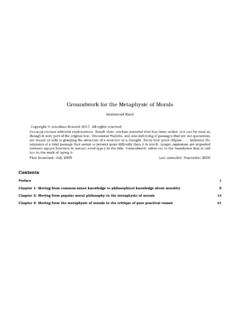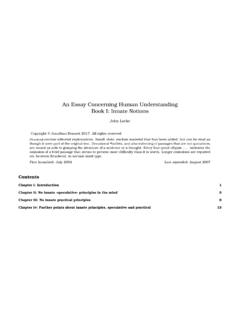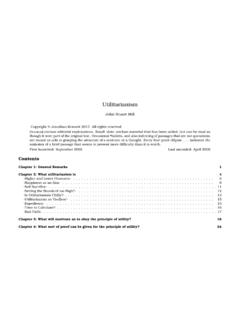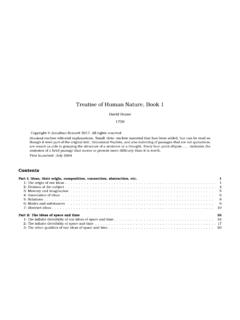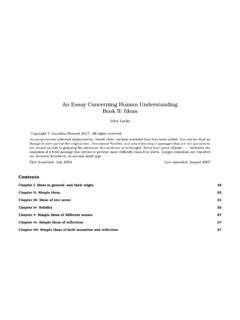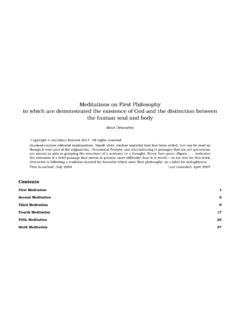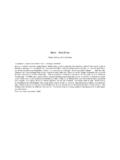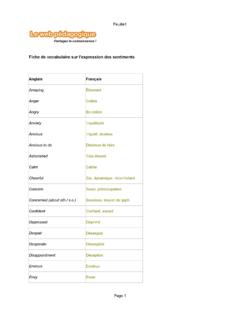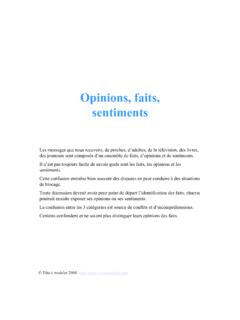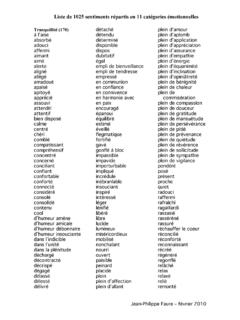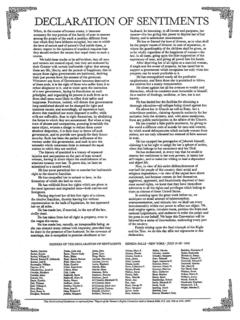Transcription of The Theory of Moral Sentiments
1 The Theory of Moral SentimentsAdam SmithCopyright Jonathan Bennett 2017. All rights reserved[Brackets]enclose editorial explanations. Small dots enclose material that has been added, but can be read asthough it were part of the original text. Occasional bullets, and also indenting of passages that are not quotations,are meant as aids to grasping the structure of a sentence or a thought. Every four-point ellipsis .. indicates theomission of a brief passage that seems to present more difficulty than it is worth. Longer omissions are reportedbetween brackets in normal-sized type. In Adam Smith s day a sentiment could be anything on a spectrumwith feelings at one end and opinions at the other.
2 This work of his is strongly tilted in the feeling direction [seeespecially the chapter starting on page 168), but throughout the present version the word sentiment will be leftuntouched. First launched: July 2008 ContentsPart I: The Propriety of Action1 Section 1: The Sense of Propriety .. 1 Chapter 1: Sympathy .. 1 Chapter 2: The pleasure of mutual sympathy .. 4 Chapter 3: How we judge the propriety of other men s affections by their concord or dissonance with our own ..6 Chapter 4: The same subject continued ..8 Chapter 5: The likeable virtues and the respectworthy virtues .. 11 Section 2: The degrees of the different passions that are consistent with propriety.]
3 13 Chapter 1: The passions that originate in the body ..13 Smith on Moral SentimentsChapter 2: The passions that originate in a particular turn or habit of the imagination ..16 Chapter 3: The unsocial passions ..18 Chapter 4: The social passions .. 21 Chapter 5: The selfish passions ..22 Section 3: How prosperity and adversity affect our judgments about the rightness of actions; and why it is easier to winour approval in prosperity than in adversity ..25 Chapter 1: The intensity-difference between joy and sympathy with joy is less than the intensity-difference betweensorrow and sympathy with sorrow ..25 Chapter 2: The origin of ambition, and differences of rank.
4 27 Chapter 3: The corruption of our Moral Sentiments that comes from this disposition to admire the rich and thegreat, and to despise or neglect the downtrodden and poor ..33 Part II: Merit and demerit: the objects of reward and punishment36 Section 1: The sense of merit and demerit ..36 Chapter 1: Whatever appears to be the proper object of gratitude (resentment) appears to deserve reward(punishment) ..36 Chapter 2: The proper objects of gratitude and resentment .. 37 Chapter 3: Where there s no approval of the benefactor s conduct, there s not much sympathy with thebeneficiary s gratitude; and where there s no disapproval of the motives of the person who doessomeone harm, there s absolutely no sympathy with the victim s resentment.
5 39 Chapter 4: Recapitulation of the preceding chapters..40 Chapter 5: Analysing the sense of merit and demerit ..40 Section 2: Justice and beneficence ..42 Chapter I: Comparing those two virtues ..42 Chapter 2: The sense of justice, of remorse, and of the consciousness of merit ..45 Chapter 3: The utility of this constitution of nature .. 47 Section 3: The influence of luck on mankind s Sentiments regarding the merit or demerit of actions ..52 Chapter 1: The causes of this influence of luck ..53 Chapter 2: The extent of this influence of luck ..55 Smith on Moral SentimentsChapter 3: The purpose of this irregularity of Sentiments ..58 Part III: Moral judgments on ourselves; the sense of duty62 Chapter 1: The principle of self-approval and self-disapproval.
6 62 Chapter 2: The love of praise and of praiseworthiness; the dread of blame and of blameworthiness.. 64 Chapter 3: The influences and authority of conscience.. 71 Chapter 4: The nature of self-deceit, and the origin and use of general rules..80 Chapter 5: The influence and authority of the general rules of morality, and why they are rightlyregarded as the laws of the Deity.. 84 Chapter 6: When should the sense of duty be the sole driver of our conduct? and when should itco-operate with other motives?..90 Part IV: The effect of utility on the sentiment of approval96 Chapter 1: The beauty that the appearance of utility gives to all the productions of art, and thewidespread influence of this type of beauty.
7 96 Chapter 2: How the characters and actions of men are made beautiful by their appearance of utility. Isour perception of this beauty one of thebasic sources of approval?.. 100 Part V: The Moral influence of custom and fashion105 Chapter 1: The influence of custom and fashion on our notions of beauty and ugliness.. 105 Chapter 2: The influence of custom and fashion on Moral Sentiments .. 107 Part VI: The character of virtue112 Section 1: Prudence, the character of the individual in its bearing on his own happiness.. 112 Section 2: The character of the individual in its bearing on the happiness of other people.. 115 Chapter 1: The order in which individuals are recommended by nature to our care and attention.
8 116 Chapter 2: The order in which societies are recommended by nature to our beneficence.. 120 Chapter 3: Universal benevolence.. 125 Section 3: Self-control.. 126 Smith on Moral SentimentsPart VII: Systems of Moral philosophy139 Section 1: The questions that ought to be examined in a Theory of Moral Sentiments .. 139 Section 2: The different accounts that have been given of the nature of virtue.. 139 Chapter 1: Systems that make virtue consist in propriety.. 140 Chapter 2: A system that makes virtue consist in prudence.. 151 Chapter 3: Systems that make virtue consist in benevolence.. 155 Chapter 4: Licentious systems.. 159 Section 3: The different systems that have been formed concerning the source of approval.
9 163 Chapter 1: Systems that trace the source of approval back to self-love.. 164 Chapter 2: Systems that make reason the source of approval.. 166 Chapter 3: Systems that make sentiment the source of approval.. 168 Section 4: What different authors have said about the practical rules of morality.. 172 Smith on Moral SentimentsSympathyPart I: The Propriety of ActionSection 1: The Sense of ProprietyChapter 1: SympathyNo matter how selfish you think man is, it s obvious thatthere are some principles[here = drives , sources of energy ; seenote on page 164]in his nature that give him an interest in thewelfare of others, and maketheirhappiness necessary tohim, even if he gets nothing from it but the pleasure of seeingit.
10 That s what is involved in pity or compassion, the emotionwe feel for the misery of others, when we see it or are madeto think about it in a vivid way. The sorrow of others oftenmakes us sad that s an obvious matter of fact that doesn tneed to be argued for by giving examples. This sentiment ,like all the other basic passions of human nature, is notconfined to virtuous and humane people, though they mayfeel it more intensely than others do. The greatest ruffian,the most hardened criminal, has something of have of course no immediate experience of whatother men feel; so the only way we can get an idea of whatsomeone else is feeling is by thinking about whatwewouldfeel if we were inhissituation.

